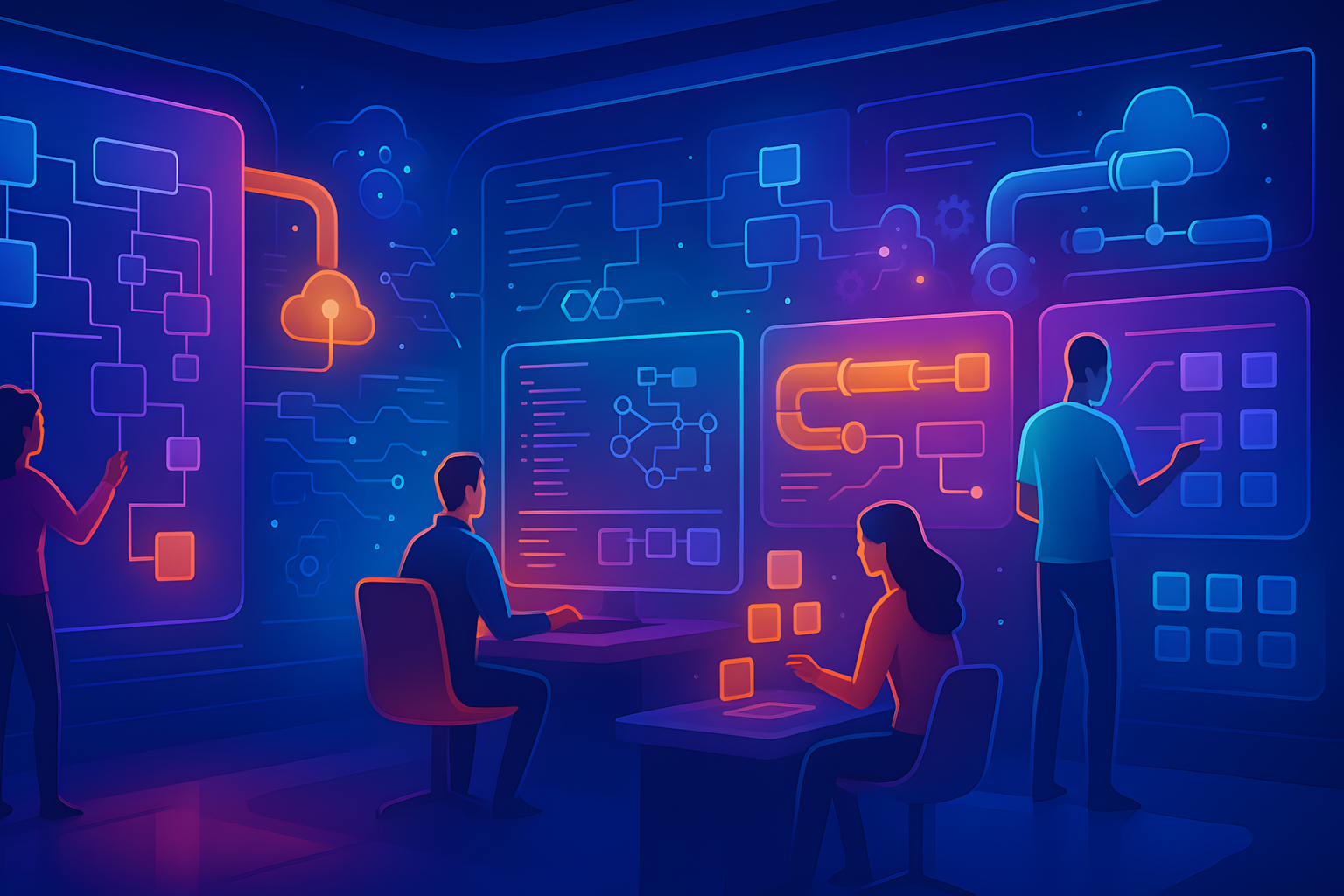Introduction: The Rise of Platform Engineering
In the last decade, DevOps transformed how we build and ship software. But in 2025, Platform Engineering has taken center stage—offering a new approach to empower developers while reducing operational chaos. According to Gartner, by 2026, 80% of software engineering organizations will establish platform teams to accelerate delivery and reduce cognitive load.
This blog post explores the future of developer productivity through Platform Engineering, revealing strategic insights that most organizations have yet to implement—and how LeanOps Tech helps build Internal Developer Platforms (IDPs) that scale with you.
What Is Platform Engineering—Really?
Platform Engineering is the discipline of designing, building, and maintaining Internal Developer Platforms (IDPs) that abstract infrastructure complexity and provide “Golden Paths”—curated, self-service workflows for developers.
Golden Path: A pre-approved, optimized path for delivering applications—built and maintained by the platform team—so developers don’t have to reinvent the wheel.
Think of it as giving your developers a well-paved highway, rather than asking them to build roads every time they ship code.
Why Traditional DevOps Isn’t Enough Anymore
DevOps promised agility, but many teams today face:
- Tooling Sprawl: 15+ tools across CI/CD, infra-as-code, security, monitoring, etc.
- Cognitive Overload: Developers juggling Kubernetes, Terraform, IAM, pipelines, YAMLs
- Inconsistent Workflows: Every team builds and deploys differently—slowing down onboarding and risking production stability
Platform Engineering doesn’t replace DevOps—it productizes it. It’s DevOps for DevOps.
The Unique Insight: Platform Engineering = Product Thinking for Internal Tools
Most organizations treat platform work as “just automation.” But high-performing teams in 2025 treat their platform as a product with:
- User research: Understanding developer pain points
- Backlogs and roadmaps: Prioritized features like template generation, self-service infra, on-demand environments
- SLAs and SLOs: For platform APIs and deployment pipelines
- Feedback loops: Metrics on platform adoption, usability, and developer NPS
This shift to product-led platform engineering is still rare—but it’s what makes companies like Spotify, Netflix, and Monzo 10x more efficient.
Components of a Modern Internal Developer Platform (IDP)
- Self-Service Infrastructure
Developers provision environments using pre-built templates (via UI or CLI) using Terraform, Pulumi, or Crossplane. - Paved Golden Paths
Standardized templates for different workloads (e.g., Node.js API, ML microservice) with CI/CD, monitoring, and security baked in. - Integrated CI/CD
GitOps-based deployment (e.g., ArgoCD or Flux) connected to code repos with policy enforcement (e.g., OPA, Kyverno). - Observability & Feedback
Real-time telemetry, logs, traces, and cost insights for apps and infra. Integrated with dashboards or chat (Slack/Teams). - Access & Policy Management
Developer identity, RBAC, secrets, and compliance integrated at every step.
The Business Value in 2025
| Benefit | Impact |
|---|---|
| 🔄 Faster Delivery | Reduce cycle time by 40–60% via automated environments and reusable templates |
| 🧠 Lower Cognitive Load | Developers focus on code, not Kubernetes or YAML |
| 🛡️ Improved Security | Centralized guardrails and policy-as-code |
| 💰 Cost Optimization | Platform team enables cost tracking and efficiency across orgs |
| 🌍 Talent Retention | Happier devs = better retention in a competitive job market |
Emerging Trends You Haven’t Heard About
1. Platform Engineering Meets AI/LLM
- AI agents are being embedded into IDPs to suggest optimal workflows, detect misconfigurations, and auto-generate pipelines based on commit history or repo type.
2. Platform-as-a-Product Portals
- Companies are launching developer portals (Backstage, Port, Cortex) with real-time app ownership maps, GitOps status, and security posture summaries—fully self-service.
3. Cognitive Load as a KPI
- Leading platform teams now measure developer cognitive load as a core metric, using surveys and heuristics like number of tools touched per deployment.
4. Composable Platform Architectures
- Platforms are moving from monoliths to modular platform services: CI, deployment, secrets, observability—each with clean APIs and pluggability.
How LeanOps Builds Scalable IDPs
At LeanOps, we specialize in designing and delivering scalable Internal Developer Platforms. Here’s how we do it:
- Platform Strategy Workshop
We align with your engineering goals, audit your tooling ecosystem, and define personas (frontend devs, data scientists, etc.). - Golden Path Design
We define and build reusable software templates with secure defaults and CI/CD baked in. - Modular Architecture
We implement loosely coupled platform services (infra, secrets, pipelines, monitoring) using Terraform, ArgoCD, Helm, Backstage, and more. - Observability & Governance
We embed cost, drift, and security tracking into the platform, with automated policy enforcement and alerting. - Enablement & Iteration
Our engagement includes documentation, enablement sessions, platform adoption metrics, and iterative improvements.
How to Get Started with Platform Engineering
| Phase | Action |
|---|---|
| 1. Discovery | Audit current tooling, workflows, and pain points |
| 2. Define MVP | Choose 1–2 workflows to standardize (e.g., deploy React app, provision DB) |
| 3. Build Golden Paths | Automate with templates and platform APIs |
| 4. Evangelize | Run onboarding sessions, collect feedback |
| 5. Measure & Expand | Track adoption, developer satisfaction, and iterate |
Final Thoughts
In 2025, developer experience is a competitive differentiator, not a luxury.
Companies that treat their platforms as products—curated, self-service, observable, and secure—will attract better talent, deliver faster, and innovate at scale. Platform Engineering is no longer “nice to have”—it’s how modern engineering happens.
At LeanOps, we help engineering teams build these platforms from the ground up, turning chaos into consistency and complexity into clarity.
Ready to Build Your Internal Developer Platform?
Contact LeanOps for a free platform maturity assessment. Let’s design a developer experience that scales with your ambition.
